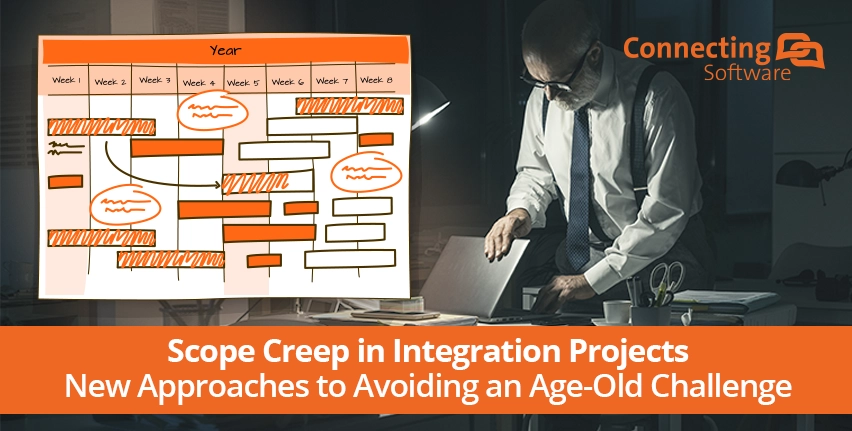Ever begun a DIY home project, thinking it’d be a weekend affair, only to find yourself a month in and nowhere near done? Welcome to the world of scope creep!
In software development, scope creep is the sneaky addition of requirements, changes, and little “just-in-case” elements after the project has started. These elements appear “out of nowhere” but make the project take longer to complete.
Specifically in software integration projects, this has always been a problem, as these projects are not simple to begin with.
Scope Creep vs. Scope Change
Now, here’s a twist: Is every change in a project’s course the dreaded scope creep? Not quite.
Some changes could be required when the project is already underway and included adequately. That is why it is important to distinguish scope change from scope creep.
Scope change implies that the project manager and the customer (or project owner) make an official decision to change a certain feature or add a new one. Scope change involves making the corresponding adjustments to the budget and timeline and communicating them to stakeholders.
Scope creep occurs in a non-official way. “Let’s add this while we are it,” “That was implicit,” or “You could also apply that feature in that other area”: those are all sentences that will generally make the scope of the project bigger and milestones more difficult to reach. They add up to the project without any official acknowledgment.
So, while scope creep introduces unplanned additions subversively, scope change is the informed choice to alter what is included in the project.
The Real Cost of Scope Creep
The negative implications of scope creep include the following:
- Time Delays
The extra effort for the new or changed feature can lead to deviations from the established timeline and significant project delays. - Financial Implications
Exceeding the budget is a common outcome. Every additional unplanned cost impacts the overall financial health of the project. - Quality and Performance
Altering project requirements can compromise the end result’s quality and performance, especially if not everyone on the team is aware of such requirement changes. Being consistent and thorough is key to achieving desired outcomes. - Team Morale
Frequent changes without clear communication can diminish team morale, leading to a lack of cohesion and reduced productivity. What is the point in trying to stick to my timeline when the project as a whole is falling behind?
Traditional Methods of Managing Scope Creep
As the scope creep problem has been around for a while, some of the methods for fighting it have been around for quite some time too:
- Strict Requirements Gathering
The idea here is to define your requirements and treat them like a roadmap. You keep your eyes on that map so you don’t get lured by every scenic detour. - Change Request Process
If you add more control and even some bureaucracy into requesting a change, the scope creep should reduce. Extra sprinkles on that ice cream? Sure, but let’s create a ticket for that. 😊 - Regular Monitoring and Reviews
Think of it as having a GPS and constantly checking if you’re on the right track. It might not avoid scope creep, but you can realize it is there sooner and act on it.
Novel Approaches to Tackling Scope Creep in Integration Projects
Although the above techniques are still applicable in some contexts, there are some more modern approaches you can consider:
Continuous Communication
Project managers can identify and address potential scope creep issues early by communicating regularly with all stakeholders. This includes communicating with the client, the software development team, and any third-party vendors involved in the project.
Here are some specific ways that continuous communication can help reduce scope creep in software integration projects:
- Establish clear expectations
The first step to preventing scope creep is to establish clear expectations with all stakeholders. This includes defining the project scope in terms of requirements, deliverables, and timeline. By setting clear expectations, project managers can help to avoid misunderstandings and surprises down the road. - Track progress and identify risks
Once the project is underway, it is important to track progress and identify any potential risks. This can be done through status reports, regular meetings, or any other type of communication. By identifying risks early on, project managers can take steps to mitigate them and prevent scope creep. - Get buy-in from stakeholders
Ensure that any scope changes require that you get buy-in from all stakeholders. This includes the client, the software development team, or even third-party vendors in some specific cases. By getting buy-in from all stakeholders, project managers can help ensure that everyone is on the same page and that changes to the scope are controlled and coordinated. - Be proactive
It is important to be proactive in communicating with stakeholders. This means not waiting for them to come to you with questions or concerns. By being proactive, project managers can help to build trust and rapport with stakeholders and identify potential problems early on.
Minimum Viable Integration (MVI)
Minimum Viable Integration (MVI) is a software development approach that focuses on delivering the most essential features of an integration project first. You can think of it like cooking - start with the base, taste, test, repeat as many times as necessary, then season and garnish.
This approach helps to reduce scope creep by preventing the project from becoming too complex or ambitious.
Here are some of the ways that MVI can help to reduce scope creep in software integration projects:
- Focus on the most important features
When you’re developing an integration, it’s easy to get caught up in adding all sorts of bells and whistles. But with MVI, you’re forced to focus on the core functionality that your users need. - Clear roadmap
MVI creates a clear roadmap for the project, which helps to prevent scope creep. The roadmap outlines the essential features that need to be developed, and it also includes a timeline for completion. This helps to keep the project on track and prevents it from getting bogged down in unnecessary features. - Early feedback
MVI allows for iterative development, which means that the project will be developed in stages. This is helpful because it allows the project team to get feedback from users early on and make changes as needed.
By focusing on the most important features and developing the project iteratively, MVI can help to keep the project on track and on budget. This is even more effective if you have faster cycles. Iterations will finish quicker, and your early feedback will come sooner.
Overall, MVI is a great way to reduce scope creep in software integration projects.
Introducing Connect Bridge as a Solution
Using a software integration platform like Connect Bridge can be pivotal in reducing scope creep during software integration projects.
Not sure what an integration platform is? Click on the diagram to know more!
Here’s how Connect Bridge can help avoid scope creep in integration projects:
- Standardized Processes
Integration platforms like Connect Bridge provide a standardized approach to integrating different systems. It is the same procedure no matter what you are integrating – you just need to use the appropriate connector. This standardization means that the project team can utilize tried-and-tested methodologies, reducing the chances of unexpected challenges that often lead to scope creep. - Reduced Custom Coding
Custom coding is often a breeding ground for scope creep. With each line of custom code, there’s potential for additional requirements or adjustments. By offering standardized connectors, Connect Bridge reduces the need for custom coding, thereby limiting scope creep. - Clearer Requirements
With Connect Bridge, the project scope becomes narrower. In other words, the project is simpler and the requirements can be defined more clearly from the onset. Stakeholders and developers better understand what can be achieved with the platform, thus eliminating ambiguous or open-ended requirements that are frequent culprits of scope creep.
- Flexibility and Scalability
One of the primary reasons scope creep occurs is because of unforeseen changes or requirements that arise due to evolving business needs. Connect Bridge’s ability to easily adapt and scale means that many of these requirements can be accommodated in a straightforward scope change that has little to no effect on the timeline.
- Reduced Maintenance
“A stitch in time saves nine” they say. When you start your integration project with an integration platform such as Connect Bridge, this will save you a lot of future scope creep problems during the maintenance phase. This is because the maintenance phase practically disappears. When new versions of the integrated software are deployed, the responsibility to adjust is on the Connect Bridge side, and no change in the existing code is needed.
In essence, by providing a clear, standardized, and flexible framework for software integration, platforms like Connect Bridge act as a protective barrier against the unpredictable winds of scope creep.
Real-world Case Study
An American equipment manufacturer was facing a symphony of challenges. They had an integration project open for 10 years. With Connect Bridge, they tuned their integration to perfection, creating harmony in no time. Dive deep into this transformative story here.
Key Takeaways
Beware of the creep (scope creep, of course). But remember, it’s not undefeatable. With the right tools, like Connect Bridge, you can keep it at bay and have your project humming smoothly.
Conclusie
Here’s your call to arms, dear reader. When you feel the shadow of scope creep lurking, be ready. Equip yourself, strategize, and maybe invite Connect Bridge to the party.
References and Further Reading
Hungry for more? For the insatiable minds, feast hier. Bon appétit!
Over de auteur

Door Ana Neto, technisch adviseur bij Connecting Software.
"Ik ben software engineer sinds 1997, met een recentere liefde voor schrijven en spreken in het openbaar. Heb je vragen of opmerkingen over dit artikel of over CB Dynamics 365 Seamless Attachment Extractor? Ik zou graag je feedback hebben!"
ana@connecting-software.com

